An Interview With Gary Spencer Millidge
by Nevs Coleman 20-Oct-14
Following up his review of Meanwhile… 1, Nevs Coleman interviews Strangehaven creator Gary Spencer Millidge, about (among other topics) the series’ long absence and its triumphant return in the new iteration of Meanwhile…
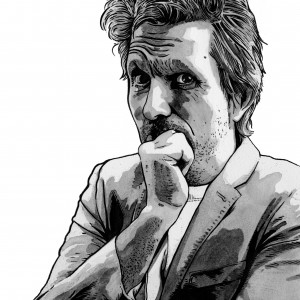 [In connection with the return of Strangehaven in Meanwhile…, I caught up with Gary Spencer Millidge to ask him a few questions … – Nevs Coleman]
[In connection with the return of Strangehaven in Meanwhile…, I caught up with Gary Spencer Millidge to ask him a few questions … – Nevs Coleman]
Nevs Coleman: So, being as tactful as you like and to get the elephant in the room out of the way, what’s been going on? It’s been nearly ten years since Strangehaven 18…
Gary Spencer Millidge: Yeah. It would have been nicer if it had been “just over five years” rather than “nearly ten” because that sounds really bad, doesn’t it? I was still heavily promoting the third Strangehaven volume, Conspiracies, and having foreign editions published in several different European countries throughout 2006 and 2007, and I started negotiating with John over a year ago now, so it feels more like five to me. Not that five years isn’t bad enough.
I suppose the simple answer is that self-publishing an issue of Strangehaven once or twice a year wasn’t enough to survive on by itself. It always made a modest profit, but certainly not enough to support a household. My lucrative, if brief, association with Bongo Comics made me think that there was a possibility that I could find freelance work within the comics industry that would supplement my income from my own material.
Instead, I ended up losing a sizeable chunk of a year being invited to write pitches and synopses for a couple of publishers for projects that weren’t eventually picked up. The intention was to write and let the publishers find an artist, so it wouldn’t take up too much of my time. Initially the editorial feedback was very positive but for whatever reasons they didn’t happen.
What did happen was I ended up getting a gig by recommendation from Bryan Talbot to write a couple of How-to-draw type books for New Holland Publishing. I got the amazingly talented James McKay to do most of the illustrations for me, and we knocked those out pretty quickly.
I’d also put together a proposal for a book on self-publishing comics at the behest of Tim Pilcher who was commissioning editor at Ilex Press at the time. That didn’t work out either, but led to my doing Comic Book Design for the same publisher.
Nevs: Obviously we need to remind people that Comic Book Design exists, because it’s automatically one of those books that needs to be on every aspiring comic creator’s shelf, next to Will Eisner’s Comics & Sequential Art, Scott McCloud’s Understanding Comics and Dave Sim’s Cerebus Guide To Self Publishing. How did the book come about, did you have any problems putting it together and would you consider doing a Volume 2?
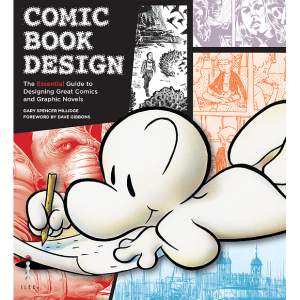 Gary: It’s very kind of you to say so. All of those books you mention are the most-thumbed on my shelves. Comic Book Design was great fun to do, as a lot of time was spent rummaging through my own comics and books and scanning the best examples of comics design and storytelling. It’s not so much of a how-to book, but more like an exploration of the different choices you can make as a storyteller, and to showcase the best examples the medium can offer to inspire the budding creator.
Gary: It’s very kind of you to say so. All of those books you mention are the most-thumbed on my shelves. Comic Book Design was great fun to do, as a lot of time was spent rummaging through my own comics and books and scanning the best examples of comics design and storytelling. It’s not so much of a how-to book, but more like an exploration of the different choices you can make as a storyteller, and to showcase the best examples the medium can offer to inspire the budding creator.
There certainly were frustrations. It had an editorially defined fixed chapter format, so that was restrictive; I had so many words per spread that I could use, regardless of how much I wanted to say about a certain aspect. I had gathered together many gorgeous examples that there simply wasn’t room in the book for; it was heartbreaking to leave them out. Initially we didn’t think we could use any images from DC as their copyright department was being distinctly difficult at the time. Thanks to a tip-off from Joel Meadows though, we discovered that they might allow us to reproduce some images so long as they didn’t exceed a certain percentage of the book’s total number – something weirdly arbitrary and miserly like 13%. So at the last minute, I started substituting various images for DC-owned ones, just to add some balance.
Nevertheless, I do think it’s a pretty lovely-looking book. I’m not a fan of the cover on the American Watson-Guptill edition, but it’s the same interiors. Ilex had plans for a whole series – Comic Book Lettering, Comic Book Anatomy and so on, and I actually produced sample pages for a potential Comic [sic]. But none of those ever came to pass either.
So, not only is a second volume unlikely, I’m not sure I’d want to undertake anything further that I ultimately don’t have copyright ownership of. The books I’ve done for Ilex were essentially work-for-hire, and while they paid pretty well (compared to what Strangehaven brought in), the problem is everything I do turns into a labour of love. I always put my heart and soul into a project, and as a result spend too much time and effort for too little reward… which is fine if I can reprint it years down the line, sell foreign rights, convert it to digital or whatever, and create additional income. That’s the arrangement I have with Soaring Penguin for Strangehaven. But Ilex operates on a different publishing model, and I’m not sure it’s right for someone like me who’s so meticulous and precious about their creative work to sign up for that sort of deal.
Nevs: While it’s been a while since the last issue of Strangehaven, you’ve clearly been busy, putting out not one but two books on Alan Moore. Talk me through that, because both projects sound like an insane amount of work. I’d like to suggest either Soaring Penguin or someone else reprints Portrait Of An Extraordinary Gentleman, please. Those conversations between Moore and Sim were fascinating.
Gary: Everything I do turns into an insane amount of work, it’s in my DNA. If I’m set a task, I try to figure out the most complex, time-consuming way of completing it. Portrait of an Extraordinary Gentleman was pitched to me by the translator (“smoky man”) and publisher (Omar Martini) of the Italian language edition of Strangehaven, while I was still working on the third book, Conspiracies. They were producing a 32-page comic-book sized tribute book to celebrate Alan Moore’s 50th birthday, and would I like to publish the English language version?
Somehow this turned into the 352-page volume that was published in Spring 2003. It was always to be a charity project in aid of various Alzheimer’s organisations, so I took no money for my work on it, and it ended up taking about nine months to produce. The only reason I could afford to do it was that I had just completed the Bart Simpson’s Treehouse of Horror strip for Bongo, and I was paid handsomely for it. The Portrait book raised almost $37,000 though, and I’m very proud of that fact.
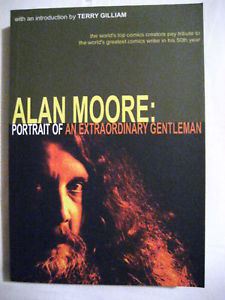 I think a reprint is a non-starter. It would be hard to get permission to reprint everything for a start, and the financing of it would be very tricky – you would have to either find a publisher willing to donate many man hours into it as a charity project, or somehow negotiate fees with 150+ creators and dozens of image rights holders to ten-year old material. Smoky man intermittently continues to post many of the contributions (with permission from the creators) on his blog Alan Moore World.
I think a reprint is a non-starter. It would be hard to get permission to reprint everything for a start, and the financing of it would be very tricky – you would have to either find a publisher willing to donate many man hours into it as a charity project, or somehow negotiate fees with 150+ creators and dozens of image rights holders to ten-year old material. Smoky man intermittently continues to post many of the contributions (with permission from the creators) on his blog Alan Moore World.
By the end of it, I had bags under my eyes, my hair was streaked with grey, I had neglected to shave for months, and when I looked in the bathroom mirror I saw Alan Moore staring back out at me. So I swore off ever doing anything Alan Moore-related ever again.
Then about a year after I had finished Comic Book Design for Ilex – I’m guessing this would be 2010 – Tim Pilcher called me and offered me the opportunity to write what turned out to be Storyteller. I was a little reluctant to take on the same subject again, lest I be forever characterised as some sort of Moore-obsessed groupie rather than a comic creator who did a bit of writing on the side. But the money was pretty decent (albeit under the same no-ownership flat-payment terms) and I figured I could pretty much just use the twelve-page biographical strip I’d created for Portrait as a basis, and Bob’s your uncle. How wrong I was.
It turned into an intense, year-long excavation of Moore’s life and work, and the man himself couldn’t have been more helpful or more gracious. I think there was some amazing visual material unearthed, and the book ended up looking spectacular. Nick Jones and everyone at Ilex really put a lot of effort into making it a thing of beauty. Even the bonus audio CD was a work of art in itself. There were similar frustrations of word count limitations, and as each section had to be sent off for design and proofing as I wrote it, I ended up blathering on a bit too long about Captain Britain and not enough about Moore’s performance works. Although one review did criticise me for the complete opposite of that.
But again, with the help of people like Dave Whitwell, Pádraig Ó Méalóid and Gary Lloyd, I managed to create a work that I’m very proud of.
 Nevs: I’m afraid I’m not one of those interviewers who wants to talk to you about which kind of pencil or graphics tablet you use, but I am intrigued by the look of Strangehaven, because it looks like literally nothing else, and I’m always wanting to know about the thought processes of people who aren’t just looking at comics for their work. There’s a number of guesses I could take to your influences, but illuminate to our audience at home who had an impact on you?
Nevs: I’m afraid I’m not one of those interviewers who wants to talk to you about which kind of pencil or graphics tablet you use, but I am intrigued by the look of Strangehaven, because it looks like literally nothing else, and I’m always wanting to know about the thought processes of people who aren’t just looking at comics for their work. There’s a number of guesses I could take to your influences, but illuminate to our audience at home who had an impact on you?
Gary: I’ll take the comment that Strangehaven doesn’t look like anything else as a compliment. I think it’s important to try to be yourself, and to allow your personality to show though in everything you do. I don’t see any benefit in trying to replicate someone else’s style because you inevitably end up being an inferior version of that writer or artist.
I don’t really study how-to books. I buy all of them and flip through them, but quite frankly, it all sounds like a lot of hard work. That’s why I didn’t attempt to demonstrate to anyone on “how to draw” in Comic Book Design. You either have the aptitude and patience to practise and figure it out for yourself, or you don’t. I’m sure there are people who will say I ought to read a book on how to plot properly, or whatever, but I always wanted Strangehaven to be non-conformist and quirky. I never wanted to tell a story the same way as everyone else, and I can’t help but think that these types of books lay down too many rules which can stifle intuitive creativity.
As for the visual aspect, I’ve always appreciated a wide range of different artists, and I hope the work I featured in Comic Book Design reflects that. I enjoy work by James Kochalka as much as I do Becky Cloonan’s or European artists like Miguelanxo Prado. There are honestly far, far too many artists whose work I love to start listing them, and it’s not something that would entertain anyone but myself.
But in terms of actual influences, I think I can probably trace my love for heavy rendering back to Alfredo Alcala’s inks over John Buscema’s pencils in the Savage Sword of Conan black and white magazine back in the 1970s. I used to trace the linework and try to figure out how he did it. It never occurred to me that he used a brush. I had been given a Rotring rapidograph by my older brother who said that it was a professional inking tool, and I tried to replicate Alcala’s lines with those things for years, so I was fucked from the start.
I always loved the solidity of Buscema’s artwork. Everything he did looked balanced, like it was taking up physical space, perfectly proportioned and in perfect perspective. But it was the flashy late ’60s/early ’70s Marvel artists like Jim Steranko, Frank Brunner and Jim Starlin that really inspired me when I first seriously started drawing my own comics.
It’s probably hard for anyone to believe now, but when I first started plotting Strangehaven, I was hugely inspired by Keith Giffen’s Ambush Bug mini-series. That’s where the nine-panel grid came from. I wanted to use a high-contrast black and white, craggy Ted McKeever/José Muñoz line so I could churn the pages out quickly. For whatever reason, I took some photographs for reference and decided that a more photorealistic style would work better, and once again I was fucked.
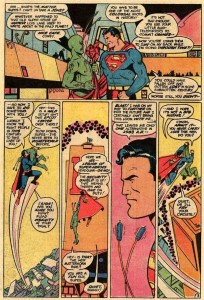 As for theme, I’ve often stated that my original intentions for Strangehaven was to create a sort of ’60s television style English rural mystery along the lines of The Avengers and The Prisoner. But I was also buzzing about Twin Peaks which had just aired and I thought I could transplant some of its elements into the English countryside. Also at that time comics had been moving towards more slow-moving, reality-based stories, like Love and Rockets (particularly Heartbreak Soup), Dave McKean’s Cages and Moore and Sienkiewicz’s Big Numbers. I was particularly fond of McKean and Sienkiewicz’s illustrative styles, as well as their use of photo reference, and their level of skill and imagination is something I still aspire to.
As for theme, I’ve often stated that my original intentions for Strangehaven was to create a sort of ’60s television style English rural mystery along the lines of The Avengers and The Prisoner. But I was also buzzing about Twin Peaks which had just aired and I thought I could transplant some of its elements into the English countryside. Also at that time comics had been moving towards more slow-moving, reality-based stories, like Love and Rockets (particularly Heartbreak Soup), Dave McKean’s Cages and Moore and Sienkiewicz’s Big Numbers. I was particularly fond of McKean and Sienkiewicz’s illustrative styles, as well as their use of photo reference, and their level of skill and imagination is something I still aspire to.
My whole approach to self-publishing itself was greatly informed by Dave Sim of course, and Martin Wagner, Jeff Smith, Terry Moore et al., as well as Paul Grist and Nabiel Kanan in the UK. Those guys showed me the way.
Nevs: I was so happy when you brought forward the notion of the Golden Section, because I’d been looking at pages of comics art for years and trying to quantify why they were “wrong” in their composition without being an art-snob about it. I literally read the theory and said “Yes! That’s why a Bryan Talbot or Moebius page instinctively works and someone whose just putting together a swipe file from last year’s comics isn’t going to get it!” I think this a thing that needs expanding on. Can you talk us through this, please, Gary?
Gary: I think it is instinctive. I don’t think you need to create precise measurements and laydown dozens of construction lines to figure it out. I know Bryan Talbot does this on occasion, and he’s pretty much an expert on the Golden Section’s use in comics. He used it a lot in Heart of Empire. The American comic book page is pretty much the Golden Section proportions, and the common tendency to split the page into three tiers follows the classic rules. The nine-panel grid splits each tier into three again, and so conforms to the ratio.
But if you have any natural design sense it comes naturally. In Comic Book Design, I analyse a Gilbert Hernandez panel which conforms beautifully and precisely to the Section, which I prove with the use of an overlay. A while after the book came out, I saw Gilbert at San Diego Comic Con and told him that I’d used his work to demonstrate the famous ratio. He said he’d never even heard of the Golden Section.
It’s a fascinating subject because it’s also found everywhere in nature, in things like flowers, shells, DNA and galaxies. But there’s no point in me going on about it as you can just Google it.
Nevs: Finally, it’s Winter 2014. The state of Comics. What do you reckon?
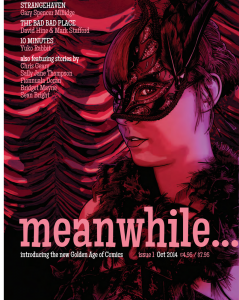 Gary: I reckon it’s in a pretty healthy state. Sure, there are challenges, and the marketplace is constantly shifting, but doom mongers have been announcing the death of comics pretty much for as long as I can remember.
Gary: I reckon it’s in a pretty healthy state. Sure, there are challenges, and the marketplace is constantly shifting, but doom mongers have been announcing the death of comics pretty much for as long as I can remember.
Has there ever been a more diverse or prolific time for comics? Yes the direct sales market is shrinking, and the product is getting ludicrously expensive, but Marvel and DC are primarily character licensing entities these days anyway. Image though, has been a revelation in recent years, and they are producing some beautiful material, allowing seasoned professionals to do what they want to do, free from corporate restrictions and pointless cross-overs.
The growth of independent book publishing and the diversity of material they are producing – particularly in the UK – is astonishing. The sheer number of lavish hardcover graphic novels and ongoing archival projects is mind-boggling. Who the hell is buying all this stuff? The growth of digital platforms is something I know very little about, but that all seems very promising as well.
Never in the history of this medium has a potential creator had such sophisticated professional tools at their disposal and so many publishing outlets for their work…and it’s bringing out unprecedented numbers of fresh and exciting comic creators into the public gaze.
I’m excited. Aren’t you excited?
Tags: Gary Spencer Millidge, Meanwhile..., Strangehaven
Hi,
Do you not think that Gary Spencer Millidge has done more damage than good to the indie comic scene with Strangehaven? I myself will never purchase another indie book until the entire series is completed because this is not the first time I’ve started a series I’ve really enjoyed only for it to finish without an ending. As far as I’m concerned Gary Spencer Millidge owed it to his fans to continue with the series (even one issue every year or two) and his excuses just seemed like hot air to my mind (and many others I know). At the end of the day he just couldn’t be bothered to continue with the series. Shame on you!!!
Aaron
Unfortunately life happens, and so does ill health, and a multitude of other reasons (that are not ‘hot air’ ) have caused the slowing down of issue StrangeHaven issue releases. (Not to mention that self publishing and indie publishing are an expensive endeavour for the maker.) However I can assure you that Millidge has been working diligently to bring this series to a close. It has not as you wrongly suggest ‘finished without an ending’- Meanwhile have published a number of instalments since this article was published, and I for one really look forward to seeing the resolution in the (hopefully) not too distant future.